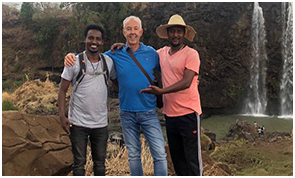Day 1: Drive to Arbaminch, on the way visit Dorze village
On the way visit two different villages, Alaba village and one of the Dorze people who live on the Guge Mountain; they are famous for their beehive bamboo houses and weaving skills. In their society, only the women do the spinning of the cotton, while only the men are allowed to weave the traditional cloth.
Day 2: Day trip to Nechi-Sar National Park
After breakfast drive to Nechi Sar National Park to visit many species of birds and mammals. This Park is located in the Rift Valley. It is enriched with many species of birds and mammals; African orange-bellied parrots, bustards, weavers, Somber rock-chat, yellow-throated serin, Red-fronted barbet, Pygmy baits, Lesser striped swallow, and Anubis Baboon, Black-backed Jackal, Bat-eared Fox, Egyptian Mongoose, Warthog, Soemmering’s Gazelle, Lesser Kudu, Salt’s Dikdik, etc. After lunch you will take a boat trip on the 3rd largest lake in Ethiopia called Chamo; it is famous for big Crocodiles, Hippos, and water birds.
Day 3: Drive to Jinka, on the way visit tribes and depending on the date, their local
After breakfast drive to Weyto via the town of Key Afer. On the way visit the Konso village, where the people wear colorful costumes, and use their steep land through impressive terracing; through annual wooden grave marks they express their status. Their three-storey community house called Mora is impressive; all the young boys above 12 years old stay there every night inside till they marry. - Have lunch in Weyto and continue driving to the town of Jinka.
Day 4: Excursion to Mago Park to visit the Mursi tribe, the afternoon spend at museum
Drive to Mago National Park to visit the Mursi people in their village. The Mursi are well known for the large clay discs their women wear inserted in their lower split lip. The Mursi women start cutting their lips between the age of 12 and 16 and thereafter, they put small wooden plugs into the hole and change it every night with the bigger one to stretch the lips till it can hold a 6 inch (15cm) round clay disc. The Mursi men wear very little, although a cotton wrap is becoming more common now. After lunch drive to Turmi via Dimeka. If the day is Saturday or Tuesday, you will have a chance to see the colorful weekly market at Dimeka.
Day 5: Drive to Turmi, on the way visit Bena tribes and possibly local market
Just like most of the indigenous tribes in the lower Omo Valley, the Bena practice ritual dancing and singing. The men often have their hair dressed up with a colorful clay cap that is decorated with feathers. Both the men and women wear long garments and paint their bodies with white chalk. Women of the tribe wear beads in their hair that is held together with butter.
Day 6: Excursion to Omorate, cross Omo River to visit Dassanech tribe, afternoon Hammer village
First time, in the Omo Valley, travelers witness Ethiopia's many ethnicities and cultural traditions. The Southern Cultural Route takes travelers to the heart of the most remote tribes, whose animist beliefs strike a chord with the true African experience.
In the afternoon drive to Hammer people who have a bull jumping ceremony; This ceremony is a transformation for young boys from young to adulthood; During the ceremony, you see the real Hamer traditional dance called Evangadi; and also the women from the jumper’s family are being beaten by his friends to show their love to the Jumper and that he is ready for adulthood.
Day 7: Drive to Yabello on the way visit Arbore and Borana tribes and villages
Arbore people are pastoralists (livestock farmers). They believe that their singing and dancing eliminates negative energy and with the negative energy gone, the tribe will prosper. The women of the tribe cover their heads with a black cloth and are known to wear very colorful necklaces and earrings. Young children wear a shell type hat that protects their heads from the sun. The Abore use natural colors made from soil and stone for their Body paint.
Traditional dancing is practiced by the tribe and wealth is measured by the number of cattle a tribesman owns.
Day 8: Drive to Langano via Wondo Genet
After breakfast drive to Wondo Genet via Awassa. The route is breathtakingly beautiful and leaves you with a lasting experience of the surrounding nature. Wondo Genet is situated in the mountain chain and jungle, which is the best place for nesting of various species of birds. It is also famous for its hot springs and the modern swimming pool makes your stay unforgettable. Bishangari Eco Lodge is a truly beautiful and tranquil place where you will have a great time. It combines four unique ecological zones: a secluded setting that is host to over 400 bird species; a diverse range of wildlife; a spectacular array of plant life; and un-spoilt biodiversity
Day 9: Drive back to Addis, in the Afternoon city tour and shopping, evening dinner at cultural restaurant, then departure home.
Depending on your interest and time availability, visit the National Museum, Ethnological Museum and Holy Trinity Cathedral. Then drive to some local gift and traditional cloth shops, Evening farewell dinner party and then transfer to airport for night departure. End of the tour!
END OF TOUR
The program can be customized upon request.




